PROCESSES
Particle processing can be overwhelming. Before you buy, our sister company XEDEV can work with you to show you the most suitable PROCEPT equipment for your process.
Spray Drying / Chilling
Spray Drying is an instant drying process for atomized solutions, suspensions or emulsions.
Spray Chilling or Cooling or Congealing is an instant solidification process for atomized molten solutions or suspensions.
Spray Drying
![]()
Spray Drying is an instant and continuous solvent evaporation process of a liquid feed, atomised in a heated gas, generating a final dried solidified particle.
Learn More
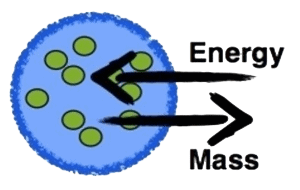 The heated drying gas moves in co-flow with the atomised feed in the process chamber where the gas transfers its heat energy to the droplets and absorbs the solvent from the droplets. The humidified cooled gas transports the particle to a cyclone, separating the final particles from the gas.
The heated drying gas moves in co-flow with the atomised feed in the process chamber where the gas transfers its heat energy to the droplets and absorbs the solvent from the droplets. The humidified cooled gas transports the particle to a cyclone, separating the final particles from the gas.
PROCEPT SPRAY DRYER SYNOPTIC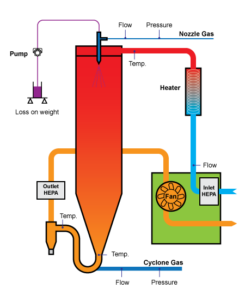 By Spray Drying particles can be engineered to a specific size, shape and function by formulating the liquid feed and designing the process.
By Spray Drying particles can be engineered to a specific size, shape and function by formulating the liquid feed and designing the process.
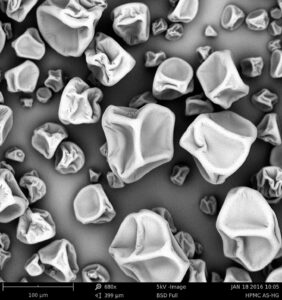
A SEM pictures of spray dried particles. Typical mean particle size varies between 1-100 µm. Here the shape is wrinkled, but they can be also spherical, irregular and be hollow, chipped, solid or perforated.
Applications:
![]() Modified/ Controlled/ Sustained Release
Modified/ Controlled/ Sustained Release![]() Stabilisation
Stabilisation![]() Solubility Enhancement
Solubility Enhancement![]() Inhalation
Inhalation![]() Flowability
Flowability![]() Reconstitution
Reconstitution![]() Taste masking
Taste masking![]() Encapsulation
Encapsulation
PROCEPT Equipment:
![]() Spray Dryer R&D
Spray Dryer R&D![]() Spray Chiller
Spray Chiller![]() Spray Dryer GMP
Spray Dryer GMP
Our XEDEV scientific expert team can support you in the development of your formulation, process, scale-up, clinical production and more… Interested? Click here for more info on Xedev.
Spray Chilling
![]()
Spray Chilling, also known as Spray Congealing or Spray Cooling is an instant and continuous solvent-free solidification process of a molten feed, atomised in a cooled gas, generating a final solidified particle.
Learn More
,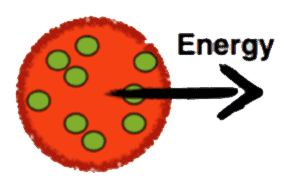 The cooled gas moves in co-flow with the atomised feed in the process chamber where the droplets transfer their heat energy to the gas. The heated gas transports the particle to a cyclone, which separates the final particles from the gas.
The cooled gas moves in co-flow with the atomised feed in the process chamber where the droplets transfer their heat energy to the gas. The heated gas transports the particle to a cyclone, which separates the final particles from the gas.
PROCEPT SPRAY CHILLER SYNOPTIC
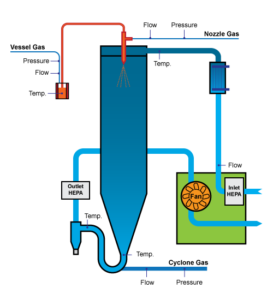
By Spray Chilling, particles can be engineered to a specific size and function by formulating the liquid feed and designing the process.
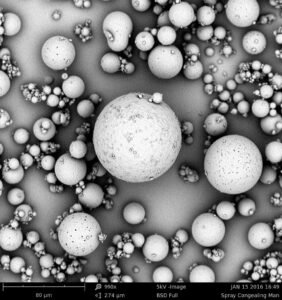
SEM Picture of Spray Chilled particles. Typical mean particle size varies between 20-250 µm. The shape is spherical and the particle is solid.
Applications:
![]() Modified/ Sustained/ Controlled Release
Modified/ Sustained/ Controlled Release![]() Flowability
Flowability![]() Taste masking
Taste masking![]() Encapsulation
Encapsulation
PROCEPT Equipment:
![]() Spray Dryer R&D
Spray Dryer R&D![]() Spray Chiller
Spray Chiller![]() Spray Dryer GMP
Spray Dryer GMP
Our XEDEV scientific expert team can support you in the development of your formulation, process, scale-up, clinical production and more… Interested? Click here for more info on Xedev.
Granulation
Granulation or Agglomeration is a process to interconnect similar or different particles in size, shape or function, to generate a final new larger particle, named granule or agglomerate, by making use of a binding agent.
High Shear Wet Granulation
![]()
High Shear Wet Granulation is a solvent batch process creating a very compact granule in a process bowl by means of an intensive mixing blade and chopper set-up.
Learn More
PROCEPT MI-PRO HIGH SHEAR GRANULATOR SYNOPTIC
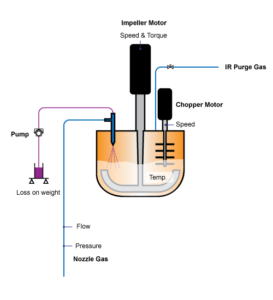
The mixer generates a powder vortex that passes the chopper. The binder, dissolved in the solvent, is sprayed onto the vortex that is compacted and spun onto the bowl sidewall. The chopper acts as a delumper and solvent distributor. The powder will transform into a homogeneous wet compact granule, that requires a drying step.
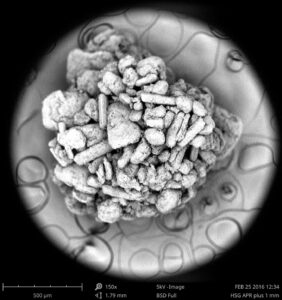
SEM Picture of a HSWG particle. Typical size varies between 100-800 µm. The shape is irregular and the particle contains cavities/porosities.
Applications
![]() Modified/ Controlled/ Sustained Release
Modified/ Controlled/ Sustained Release![]() Stabilisation
Stabilisation![]() Flowability
Flowability![]() Compressability
Compressability![]() Reconstitution
Reconstitution![]() Taste masking
Taste masking![]() Encapsulation
Encapsulation
PROCEPT Equipment:
Our XEDEV scientific expert team can support you in the development of your formulation, process, scale-up, clinical production and more… Interested? Click here for more info on Xedev.
Fluid Bed Wet Granulation
![]()
Fluid Bed Wet Granulation (FBWG) is a batch or continuous solvent process creating a porous granule in a process vessel.
Learn More
PROCEPT FLUID BED SYNOPTIC
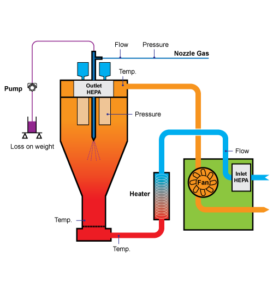
By distributing heated gas through the vessel bottom, the powder is fluidized and the particles are accelerated upwards into the expansion chamber. There the particles lose their upward momentum and consequently fall to the vessel bottom under the force of gravity, after which this movement is repeated.
The binder, dissolved in the solvent, is sprayed from the top on the particles, which adhere to each other and are partially dried by the counter flow hot gas. The solvent is absorbed by the process gas and evacuated through the process filters. This up and downwards movement combined with the binder spraying and partial drying will continue untill the required final particles size is reached. From that moment the binder spraying will end and the porous granules will be completely dried to the required final humidity.
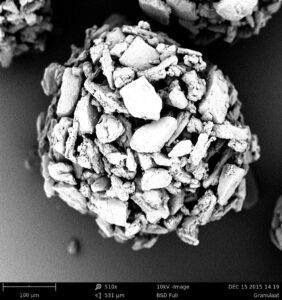
SEM Picture of a FBWG particle. Typical size varies between 50-800 µm. The shape is irregular and the particle contains large porosities.
Applications
![]() Modified/ Controlled/ Sustained Release
Modified/ Controlled/ Sustained Release![]() Stabilisation
Stabilisation![]() Solubility Enhancement
Solubility Enhancement![]() Inhalation
Inhalation![]() Flowability
Flowability![]() Compressability
Compressability![]() Reconstitution
Reconstitution![]() Taste masking
Taste masking![]() Encapsulation
Encapsulation
PROCEPT Equipment:
Our XEDEV scientific expert team can support you in the development of your formulation, process, scale-up, clinical production and more… Interested? Click here for more info on Xedev.
Continuous Melt Granulation
![]()
Melt granulation is a solvent-free process that can be carried out on a twin-screw extruder in a continuous manner.
Learn More
PROCEPT TWIN SCREW EXTRUDER SYNOPTIC
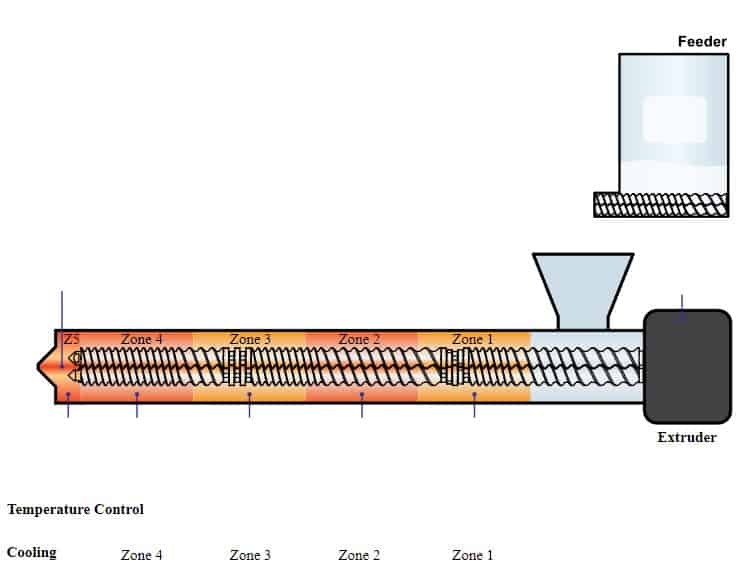
Despite its advantages, melt granulation is not widely applied. In the course of this process, the granulating agent is molten due to the elevated temperature and the shear forces. It flows around the other particles and it forms aggregates when it is solidifies.
The lack of the drying step after granulation can be considered as the main advantage as opposed to wet granulation, while the thermal load might be similar as generally low processing temperatures (<80 °C) are applied (during continuous granulation, the residence time is low, less than 30 seconds.
Applications
![]() Modified/ Controlled/ Sustained Release
Modified/ Controlled/ Sustained Release![]() Stabilisation
Stabilisation![]() Solubility Enhancement
Solubility Enhancement![]() Flowability
Flowability![]() Compressability
Compressability![]() Taste masking
Taste masking![]() Encapsulation
Encapsulation
PROCEPT Equipment:
Our XEDEV scientific expert team can support you in the development of your formulation, process, scale-up, clinical production and more… Interested? Click here for more info on Xedev.
High Shear Melt Granulation
![]()
High Shear Melt Granulation is a solvent-free batch process creating a compact granule in a process bowl by means of an intensive mixing blade and chopper set-up.
Learn More
PROCEPT HIGH SHEAR MELT GRANULATOR SYNOPTIC
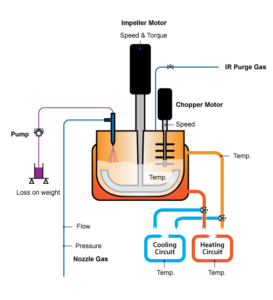
The mixer generates a powder vortex that passes the chopper. The chopper acts as a de-lumper and binder distributor. A wax or polymer will act as the binder and is present in the powder batch. The process vessel is heated and gradually warms up the powder vortex until the binder melts and interconnects all particles, which are compacted and spun onto the bowl sidewall and become a final compact granule.
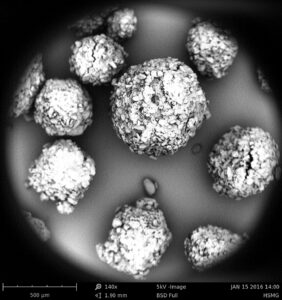
SEM Picture of a HSMG particle. Typical size varies between 50-800 µm. The shape is irregular and the particle is solid.
Applications
![]() Modified/ Controlled/ Sustained Release
Modified/ Controlled/ Sustained Release![]() Stabilisation
Stabilisation![]() Flowability
Flowability![]() Compressability
Compressability![]() Taste masking
Taste masking![]() Encapsulation
Encapsulation
PROCEPT Equipment:
Our XEDEV scientific expert team can support you in the development of your formulation, process, scale-up, clinical production and more… Interested? Click here for more info on Xedev.
Continuous Wet Granulation
![]()
Batch type wet granulation is foreseen to be partially replaced by continuous wet granulation in the pharmaceutical industry.
Learn More
PROCEPT TWIN SCREW EXTRUDER SYNOPTIC
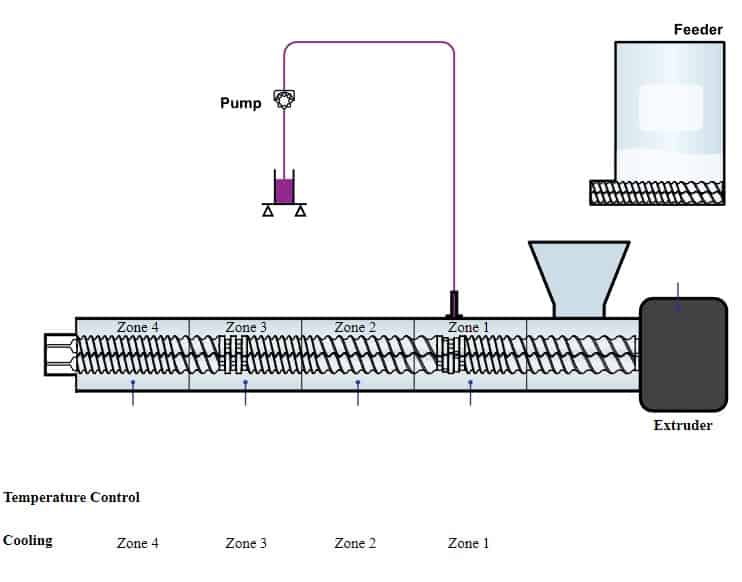
Extruding is a shift that is urged by Food and Drug Administration to achieve better and more constant product quality and less waste production. Continuous wet granulation can be executed on twin-screw equipment into which powders and granulating liquid can be fed at different ports. The powder and the liquid are sheared, homogenized and granulated due to high shear forces applied, especially at the kneading zones. With various processing and screw setups, the properties of the obtained granules can be modified according to our desires.
Applications
![]() Modified/ Controlled/ Sustained Release
Modified/ Controlled/ Sustained Release![]() Stabilisation
Stabilisation![]() Solubility Enhancement
Solubility Enhancement![]() Flowability
Flowability![]() Compressability
Compressability![]() Reconstitution
Reconstitution![]() Encapsulation
Encapsulation
PROCEPT Equipment:
Our XEDEV scientific expert team can support you in the development of your formulation, process, scale-up, clinical production and more… Interested? Click here for more info on Xedev.
Coating
Coating is a process to create a shell layer around a core; particle, granule, sphere, tablet, capsule or any other object. The process technique we apply to adhere the layer on the core is by spraying a solution, emulsion or molten mass on the core.
Fluid Bed Wet Coating
![]()
Fluid BedWet Coating (FBWC) is a batch or continuous solvent process creating a core shell layer in a process vessel by spraying from the bottom a coating solution or emulsion directly on the cores.
Learn More
PROCEPT FLUID BED WET COATING SYNOPTIC
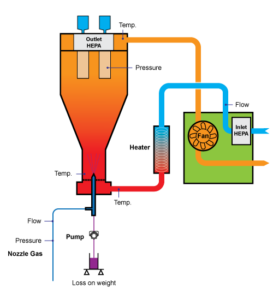
FBWC is a batch or continuous solvent process creating a core shell layer in a process vessel by spraying from the bottom a coating solution or emulsion directly on the cores (single particle, sphere or agglomerate) in a heated gas, distributed from the vessel bottom and pushing the cores upwards into the expansion chamber where they lose their upward momentum and are pulled back to the bottom by the force of gravity.
The coating material will adhere to and create a film on the surface of the cores. The process gas will absorb the solvent and is evacuated through the process filters. This up and downward movement combined with the coating spraying and solvent evaporation will continue until the required core shell thickness is obtained.
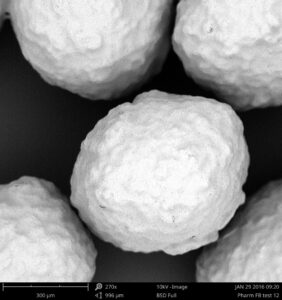
SEM Picture of a FBWC sphere of 1000µm. This process is applied for particles from 50-2000µm.
Applications
![]() Modified/ Controlled/ Sustained Release
Modified/ Controlled/ Sustained Release![]() Stabilisation
Stabilisation![]() Solubility Enhancement
Solubility Enhancement![]() Taste masking
Taste masking![]() Encapsulation
Encapsulation
PROCEPT Equipment:
Our XEDEV scientific expert team can support you in the development of your formulation, process, scale-up, clinical production and more… Interested? Click here for more info on Xedev.
Wet Pan Coating
![]()
Wet Pan Coating (WPC) is a batch or continuous solvent process, creating a core shell layer in a perforated process drum.
Learn More
PROCEPT PAN COATER SYNOPTIC
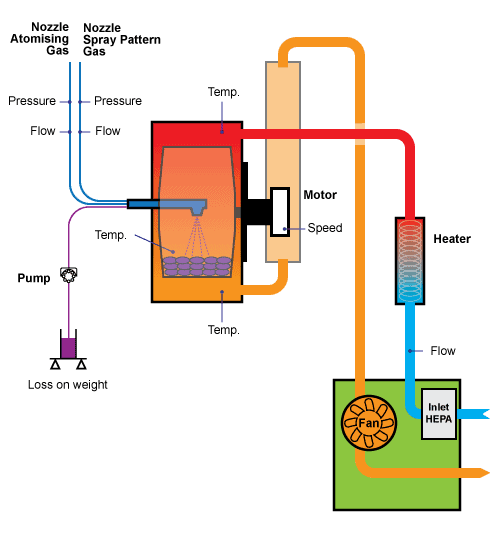
WPC is a batch or continuous solvent process, creating a core shell layer in a perforated process drum by spraying from the centre of the drum a coating solution or emulsion on the cores (spheres, tablets or capsules), in co-flow with the heated gas, distributed through the drum perforations. The cores, located on the inner surface of the drum, are gently, continuously and homogeneously blended by the scoops of the rotating drum.
The coating material will adhere to and create a film on the surface of the cores. The process gas will absorb the solvent and is evacuated through the drum perforations. This core blending with the coating spraying and solvent evaporation will continue till the required core shell thickness is obtained.
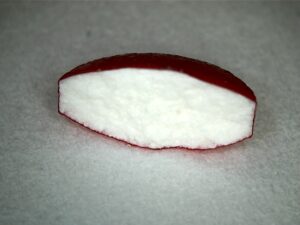
Picture of a cut WPC tablet.
Applications
![]() Modified/ Controlled/ Sustained Release
Modified/ Controlled/ Sustained Release![]() Stabilisation
Stabilisation![]() Taste masking
Taste masking![]() Encapsulation
Encapsulation
PROCEPT Equipment:
Our XEDEV scientific expert team can support you in the development of your formulation, process, scale-up, clinical production and more… Interested? Click here for more info on Xedev.
Fluid Bed Melt Coating
![]()
Fluid Bed Melt Coating (FBMC) is a batch or continuous solvent-free process creating a core shell layer in a process vessel.
Learn More
PROCEPT FLUID BED MELT COATING SYNOPTIC
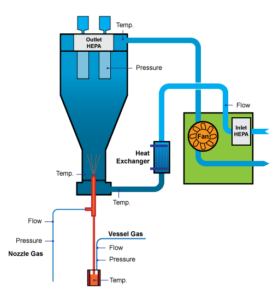
FBMC is a batch or continuous solvent-free process creating a core shell layer in a process vessel by spraying from the bottom a molten feed directly on the cores (single particle, sphere or agglomerate) in a cold gas, distributed from the vessel bottom and pushing the cores upwards into the expansion chamber where they lose their upward momentum and are pulled back to the bottom by the force of gravity.
The coating material adheres to the surface of the cores during the upward movement and solidifies by the energy transfer to the process gas. This up and downward movement combined with the coating spraying and energy transfer will continue until the required core shell thickness is obtained.
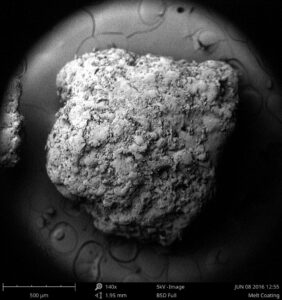
SEM Picture of a FBMC granule of 1000 µm. This process is applied for particles from 50-2000 µm.
Applications
![]() Modified/ Controlled/ Sustained Release
Modified/ Controlled/ Sustained Release![]() Stabilisation
Stabilisation![]() Taste masking
Taste masking![]() Encapsulation
Encapsulation
PROCEPT Equipment:
Our XEDEV scientific expert team can support you in the development of your formulation, process, scale-up, clinical production and more… Interested? Click here for more info on Xedev.
Melt Pan Coating
![]()
Melt Pan Coating (MPC) is a batch or continuous solvent-free process, creating a core shell layer in a perforated process drum.
Learn More
PROCEPT MELT PAN COATER SYNOPTIC
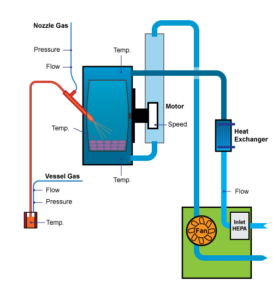
MPC is a batch or continuous solvent-free process, creating a core shell layer in a perforated process drum by spraying from the centre of the drum a molten feed on the cores (spheres, tablets or capsules), in co-flow with the cold gas, distributed through the drum perforations. The cores, located on the inner surface of the drum, are gently, continuously and homogeneously blended by the scoops of the rotating drum.
The coating material will adhere to the surface of the core where it solidifies by the heat energy transfer to the process gas that is evacuated through the drum perforations. This core blending with the coating spraying and energy transfer will continue until the required core shell thickness is obtained.

Picture of a cut MPC oblong tablet. This process is applied for cores from 1.5 mm – 10 cm
Applications:
![]() Modified/ Controlled/ Sustained Release
Modified/ Controlled/ Sustained Release![]() Stabilisation
Stabilisation![]() Taste masking
Taste masking![]() Encapsulation
Encapsulation
PROCEPT Equipment:
Our XEDEV scientific expert team can support you in the development of your formulation, process, scale-up, clinical production and more… Interested? Click here for more info on Xedev.
Extrusion
Extrusion is a powder process, generated by co-rotating screws with different configurations, to mix, agglomerate and melt powders. The screws will push the processed material through a die, delivering a wet-melt granule, a molten spaghetti or any specific shape.
Hot Melt Extrusion
![]()
Hot melt extrusion is a commonly applied continuous technology to fabricate amorphous solid dispersions of poorly soluble drugs to enhance the dissolution and the bioavailability.
Learn More
PROCEPT TWIN SCREW EXTRUDER SYNOPTIC

Hot melt extrusion is a commonly applied continuous technology to fabricate amorphous solid dispersions of poorly soluble drugs to enhance the dissolution and the bioavailability. The API and the polymer are getting molten due to the high shear forces and elevated temperature followed by complete homogenization of the components.
When the extrudate exits the die attached to the equipment, it solidifies suddenly providing no chance for the API to crystallize. Afterward, the extrudate can be forwarded for milling e.g. with a conveying belt. With continuous extrusion, you can minimize your material cost by reducing the amount of API needed for feasibility studies.
Applications
![]() Modified/ Controlled/ Sustained Release
Modified/ Controlled/ Sustained Release![]() Solubility Enhancement
Solubility Enhancement![]() Flowability
Flowability![]() Taste masking
Taste masking
PROCEPT Equipment:
Our XEDEV scientific expert team can support you in the development of your formulation, process, scale-up, clinical production and more… Interested? Click here for more info on Xedev.
Continous Wet Extrusion
![]()
Continuous wet extrusion can be executed on twin-screw equipment by adding liquid to the powder mass in the extruder.
Learn More
PROCEPT TWIN SCREW EXTRUDER SYNOPTIC

Continuous wet extrusion can be executed on twin-screw equipment by adding liquid to the powder mass in the extruder where the kneading elements create a doughy mass that is pressed, at the exit of the extruder, through a multiple perforated dye. This results in spaghetti shape strings that can be re-shaped into small beads on a spheroniser.
Applications
![]() Modified/ Controlled/ Sustained Release
Modified/ Controlled/ Sustained Release![]() Stabilisation
Stabilisation![]() Flowability
Flowability![]() Compressability
Compressability![]() Taste masking
Taste masking
PROCEPT Equipment:
Our XEDEV scientific expert team can support you in the development of your formulation, process, scale-up, clinical production and more… Interested? Click here for more info on Xedev.
Filtration
Filtration is a separation process, applied on wet slurries leaving a reactor. After filtration, the filter cake can be washed and dried within the same process unit.
Lab Filter Dryer
![]()
The PROCEPT lab filter dryer is lab scale, fully integrated and automated. It has a variable speed impeller with telescopic movement, turning both clockwise and anti-clockwise.
Learn More
PROCEPT LAB FILTER DRYER SYNOPTIC
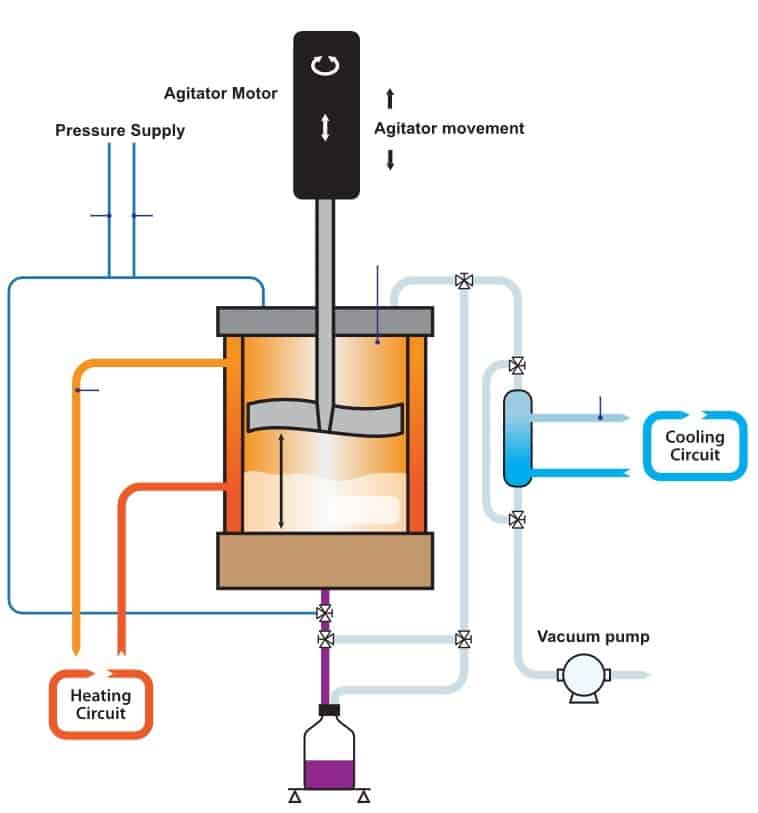
It includes a vacuum system, jacketed dust filter, glass condenser, condenser receiver vessel, bypass, vacuum pump and process pressure control. All critical process data can be recorded.
Applications
![]() API slurry filtration and drying
API slurry filtration and drying![]() Stabilisation
Stabilisation
PROCEPT Equipment:
Our XEDEV scientific expert team can support you in the development of your formulation, process, scale-up, clinical production and more… Interested? Click here for more info on Xedev.
Secondary Drying
Secondary drying is a drying step, applied down-stream of the first process step of Agglomeration, Spray Drying (in some cases), reaction or filtration, to reduce the final solvent content from the particles; agglomerate, single particle, wet cake or slurry.
Fluid Bed Drying
![]()
Fluid Bed Drying (FBD) is a batch or continuous convection drying process, using hot drying gas to absorb the solvent from a particle (agglomerate or single particle)
Learn More
PROCEPT FLUID BED SYNOPTIC
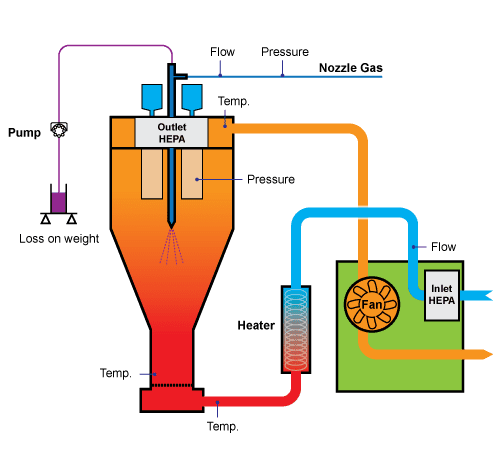 FBD is a batch or continuous convection drying process, using hot drying gas to absorb the solvent from a particle (agglomerate or single particle). The particles are fluidized by the hot gas, distributed through the bottom of the process chamber and accelerating the particles upwards into the expansion chamber, where they loose their upward momentum and fall back to the bottom by the force of gravity.
FBD is a batch or continuous convection drying process, using hot drying gas to absorb the solvent from a particle (agglomerate or single particle). The particles are fluidized by the hot gas, distributed through the bottom of the process chamber and accelerating the particles upwards into the expansion chamber, where they loose their upward momentum and fall back to the bottom by the force of gravity.
During the contact time of product and gas, the free solvent will immediately evaporate (constant drying step) and the solvent captured inside the product will first have to diffuse to the outside (diffusion drying step), where it is absorbed by the hot gas and evacuated through the process filters at the top of the vessel. This up and down-wards movement of the particles combined with the solvent absorption will continue until the required final humidity of the particles is achieved.
Applications
![]() Modified/ Controlled/ Sustained Release
Modified/ Controlled/ Sustained Release![]() Stabilisation
Stabilisation![]() Flowability
Flowability![]() Compressability
Compressability![]() Reconstitution
Reconstitution![]() Encapsulation
Encapsulation
PROCEPT Equipment:
Our XEDEV scientific expert team can support you in the development of your formulation, process, scale-up, clinical production and more… Interested? Click here for more info on Xedev.
Static Vacuum Drying
![]()
Static Vacuum Drying (SVD) is a batch conduction/convection drying process under vacuum conditions, using the heated jackets from the oven
Learn More
SVD is a batch conduction/convection drying process under vacuum conditions, using the heated jackets from the oven and the product support plates to transfer the energy required for evaporation of the solvents from the agglomerate or single particle.
The boiling point of the solvent is reduced by vacuum, allowing low temperature drying, ideally for thermo sensitive materials. During the contact time of the product with the heated jacket, the free solvent will immediately evaporate (constant drying step) and the solvent captured inside the product will first have to diffuse to the outside (diffusion drying step) for evaporation.
To support the evacuation of solvent vapour, dry gas is introduced in the oven to absorb and transport the solvent vapour towards the condenser. The heat transfer and the vapour evacuation will continue until the required final humidity of the particles is achieved.
Our XEDEV scientific expert team can support you in the development of your formulation, process, scale-up, clinical production and more… Interested? Click here for more info on Xedev.
Agitated Vacuum Drying
![]()
Agitated Vacuum Drying (AVD) is a batch conduction/convection drying process under vacuum conditions, using the heated jacket from the process vessel/reactor.
Learn More
PROCEPT LAB FILTER DRYER SYNOPTIC

PROCEPT MI-PRO VACUUM DRYER SYNOPTIC
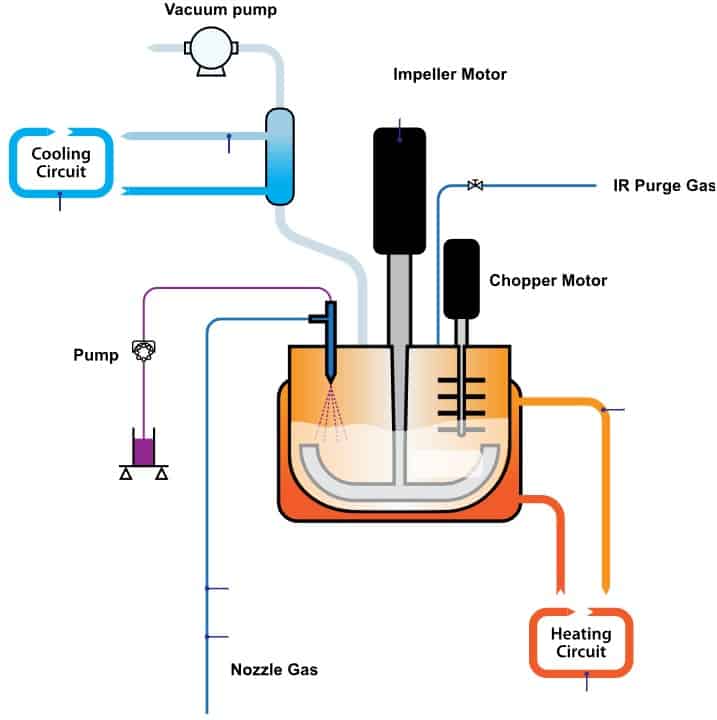
AVD is a batch conduction/convection drying process under vacuum conditions, using the heated jacket from the process vessel/reactor to transfer the energy required for evaporation of the solvents from a slurry, agglomerate or single particle. The boiling point of the solvent is reduced by vacuum, allowing low temperature drying, ideally for thermo sensitive materials.
The agitator mixes gently and moves the product towards the jacket to create a homogeneous energy transfer. A chopper/breaker is used to de-lump the batch. Different agitator types can be integrated, depending on the physical chemical status of the batch during the drying. During the contact time of product with the heated jacket, the free solvent will immediately evaporate (constant drying step) and the solvent captured inside the product will first have to diffuse to the outside (diffusion drying step) for evaporation.
To support the evacuation of solvent vapour, dry gas is introduced in the process vessel/reactor to absorb and transport the solvent vapour, via the process filter, towards the condenser. The gentle mixing, the jacket heat transfer and the vapour evacuation will continue until the required final humidity of the particles is achieved. Prior to the AVD, a slurry can be filtered and washed in the same unit, called Nutsche filter drying.
Applications
![]() Stabilisation
Stabilisation![]() Flowability
Flowability![]() Compressability
Compressability![]() Reconstitution
Reconstitution![]() Encapsulation
Encapsulation![]() Washing
Washing
PROCEPT Equipment:
![]() Lab Filter Dryer
Lab Filter Dryer![]() Agitated Vacuum Dryer
Agitated Vacuum Dryer
Our XEDEV scientific expert team can support you in the development of your formulation, process, scale-up, clinical production and more… Interested? Click here for more info on Xedev.
